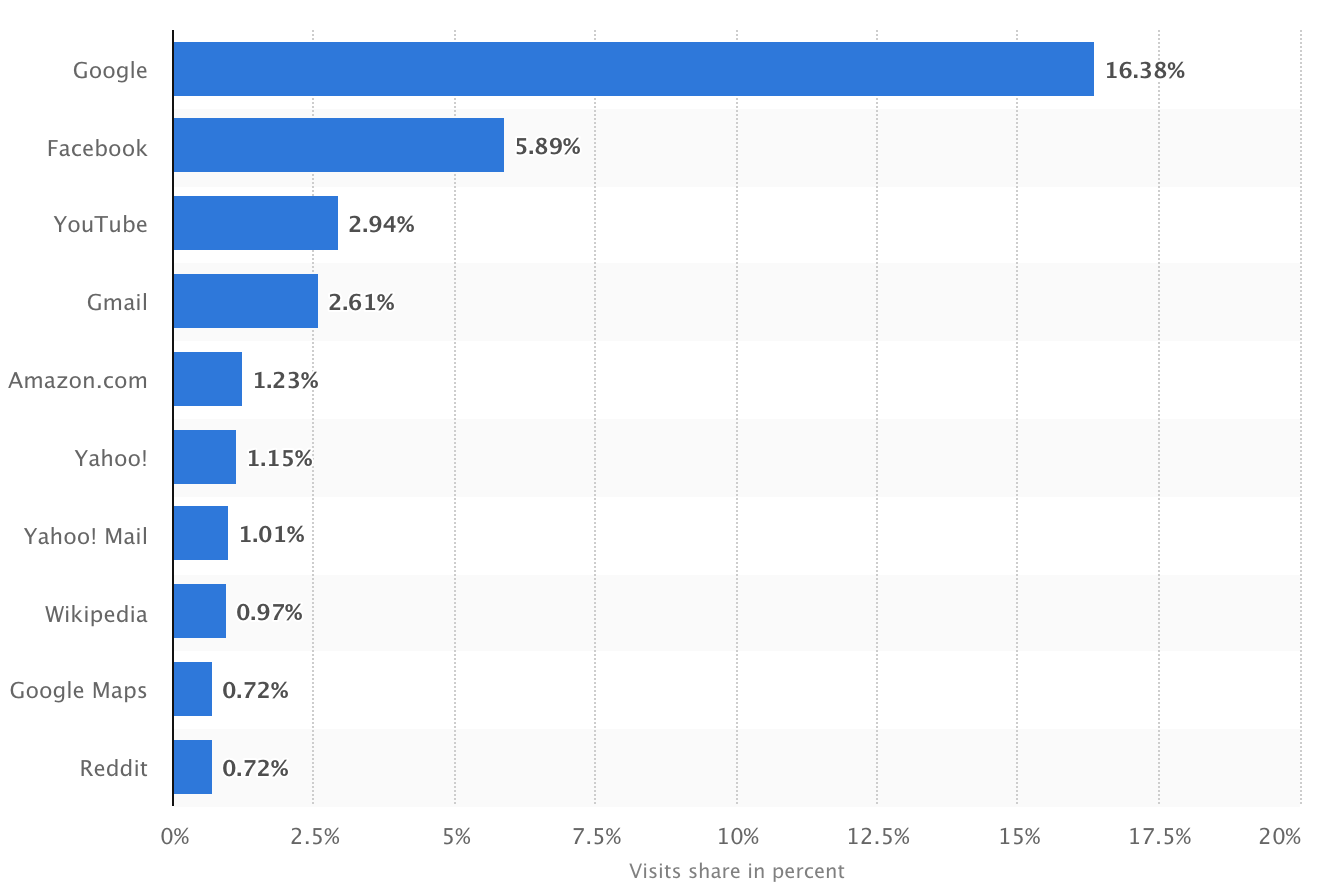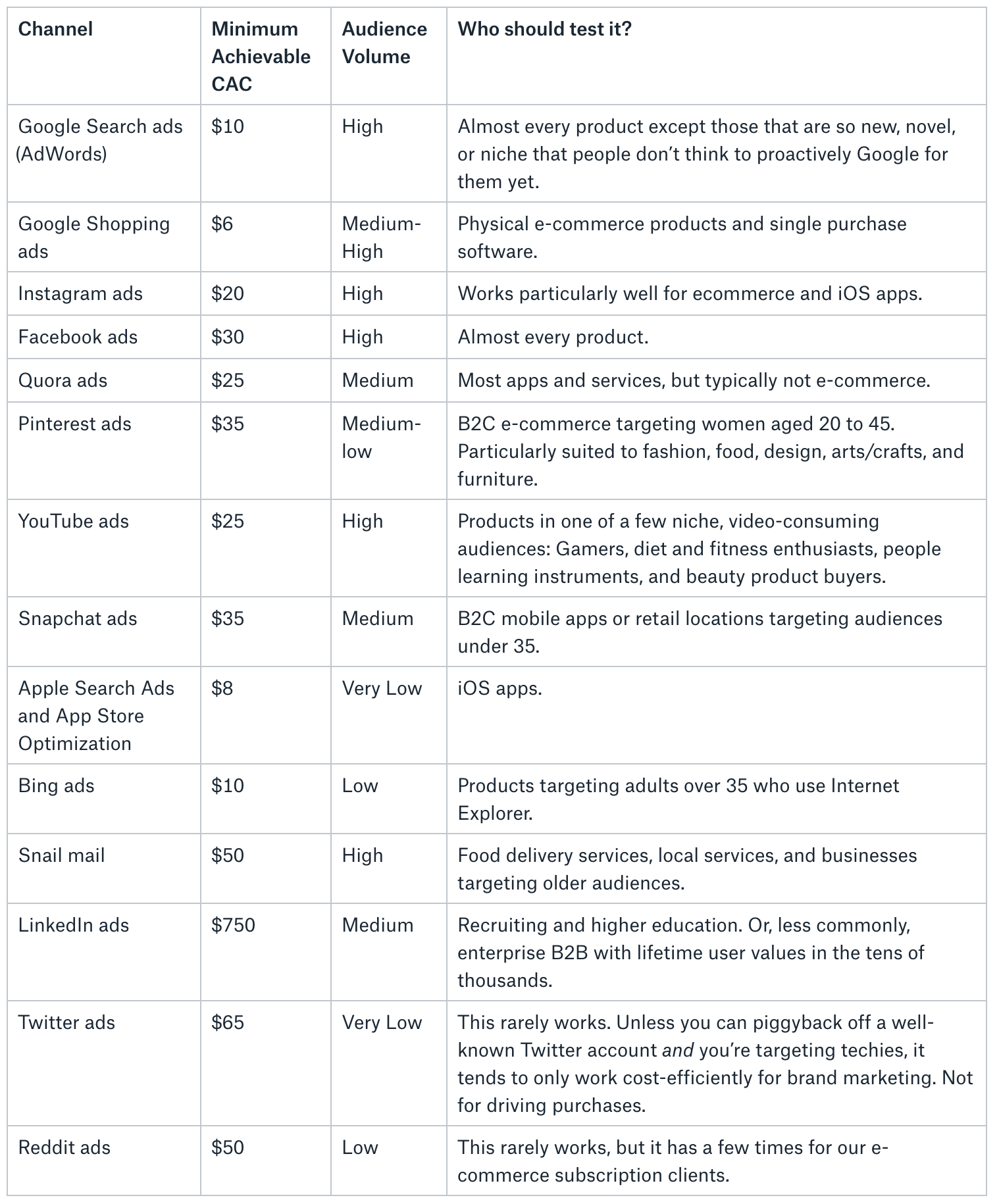This post reveals the cost of acquiring a customer on every ad channel my agency has tested. The ad channels include Facebook, Instagram, YouTube, Quora, Google Search, Google Shopping, Snapchat, LinkedIn and others. Using this data, you can reduce your costs by identifying which channels are a likely fit for your own product. Then you can focus on testing just those channels to start. I’m pulling data from my agency’s experience testing 15+ ad channels and running thousands of ads for dozens of Y Combinator startups.
This post leaves you with a prioritized to-do list of which channels might work for your product, and reference points for how much you can expect to pay if you get those channels to work.
Which ad channels should I use?
We focus on three criteria when assessing ad channels:
- Profit — You want to earn at least as much as the cost of acquiring a customer. For example, it’s uncommon to acquire an American customer through Facebook for less than $30 USD. So, your profit per customer should be at least $30 to break even. (In reality, it should likely be 3x more to account for meaningful profit and ad channel volatility.)
- Volume — If your audience doesn’t exist in significant quantities on a given ad channel, it’s likely not worth your time to experiment with it yet. Especially given your effective audience volume is probably smaller than you think: It’s not just a matter of how many people use the channel, but how many who use it also want your product today and can justify its cost.
- Targeting — The best-fitting ad channels are those that let you narrowly target your desired audience. If they can’t do this, you’ll be forced to target broadly, which wastes dollars on the wrong eyeballs. This means your customer acquisition cost (CAC) is more likely to exceed your profit margin.
In short, to succeed with ad channels, your product should earn sufficient profit and have a sufficiently large targetable audience.
This means that the higher your profit margins are, the more ad channels you can aggressively test. (This is why we sometimes advise clients to modify their product roadmap to justify a pricing increase.)
To conclude whether your product can hit these cost and audience thresholds, you typically must spend a statistically significant amount of money on each ad channel. (And there are many channels you could test.) In our experience, it often costs $500-$3,000 USD to rule out a single channel — and that’s if you’re already experienced with running ads on it.
(If you want to learn more about assessing ad channels, you can review my growth handbook.)
That’s why the data I provide in this post is useful: It helps you significantly refine your experimental ad budget so that you can do much more with it.

The percentage of internet traffic captured by the major sites. Several are ad channels themselves: Google, Facebook, YouTube, Reddit and (recently) Amazon.
Which channels might work for my business?
Before we explore the cost of ad channels, I’ll provide a framework for identifying which channels historically work for different business types.
The following are not ironclad rules, but rather starting points to help you focus. That’s the theme of this post: spend efficiently so you can experiment maximally.
If you sell to consumers
- If you’re a SaaS app — You’re more likely to succeed with Facebook ads, Quora ads and content marketing. You might also succeed with Google Search.
- If you sell physical goods — You’re more likely to succeed with Instagram ads, content marketing and PR. You might also succeed with Pinterest ads, Google Search and Google Shopping.
- If you’re a mobile app — You’re more likely to succeed with Instagram ads, Facebook mobile ads and Apple search ads. You might also succeed with Snapchat ads and Google Search.
If you sell to businesses
- If you have a niche audience with a very high average revenue per user (ARPU) — For example, an enterprise SaaS app charging over a thousand dollars per month. You’re more likely to succeed with sales (cold email, networking and LinkedIn messages) and lead generation through Facebook ads, Quora ads and Google Search. You also might succeed with Instagram ads and content marketing.
- If you have a broad audience with a high ARPU — For example, an SMB SaaS app charging $200 per month. The previous section applies here, with two modifications: 1) You might be able to de-prioritize sales in favor of ads, which are typically more scalable. 2) Content marketing is more likely to work, although it typically takes a while to kick in.
- If you have a niche audience with a low ARPU — For example, a niche SMB SaaS app charging $25 per month. Perhaps rethink your business model if you’re wanting to make more than $2 million USD per year, because it may be difficult. Niche B2B businesses with low ARPU typically cannot afford ad channels nor sales. Further, if they’re niche, they might not be able to take sufficient advantage of network effects and referrals.
- If you have a broad audience with a low ARPU — For example, a broadly appealing SaaS app that charges $25 per month. You’ll most likely succeed with content marketing, referrals, network effects and word-of-mouth. (Plus Apple Search ads if you’re a mobile app.) You will probably have a hard time affording ad channels, however.
How much does each ad channel cost?
The ad channels below are ordered by their frequency of becoming profitable for our clients.
Note the minimum achievable CAC (customer acquisition cost) column. This is how much a typical business that successfully makes the ad channel work can expect to pay on average. You’ll want to compare this minimum achievable CAC figure to your own profit margins.
My previous disclaimer applies here too: What I list below are not ironclad rules, but rather shorthand for helping prioritize your ad channel spend.
In fact, there will be many exceptions for many businesses. Here are a few reasons why:
- Expensive products generally have higher CACs because fewer people are willing to pay higher prices.
- Unenticing ads and websites have higher CACs because the conversion rates from ad impression to ad click, then landing page to purchase, are lower.
- Products targeting higher-income audiences (e.g. consider the value of software developers versus retired 70-year-olds) have higher ad impression costs, which can result in higher CACs.
- And many other factors I don’t go into here.

What do I do with this data?
Here’s how to prioritize the ad channels above for your own business:
Rule out the channels on which your desired audiences aren’t targetable. (Refer to the Who should test it? column, plus use your common sense. For example, most 70-year-olds are not on Reddit. And so on.)
Next, rule out the channels you can’t afford:
- First, for the short-term, add a 2x multiplier to the CAC numbers I’ve listed. That is, if you don’t have experts running your ads. Because my CAC numbers are achieved using my agency’s expertise.
- Second, determine whether your profit margin per sale/subscriber is at least twice as high as that CAC number that you just 2x’ed. For example, if the CAC I list above is $10, you want to earn at least $40. Otherwise, you’re not leaving yourself enough profit nor enough profit buffer against future ad channel volatility. (In practice, businesses often aim for at least a 3x multiple of their CAC.)
Order the channels that remain by how high volume your target audiences are on them.
Then test one channel at a time. Expect to spend $500-$3,000 on average per channel to acquire enough data to rule it in or out.
Where you fall in that cost range can depend on your maximum acceptable CAC plus how many distinct audiences and value propositions you want to test. (Specifics beyond this are outside the scope of this post.)
What’s next?
First, with this understanding of the importance of per-channel CAC, consider whether you can modify your product’s roadmap to increase your pricing. (If it’s currently low.) Because higher pricing means higher profit, which means you have a greater chance of making more of these ad channels work.
And that can go a long way, because we often see that a client only needs one channel to become profitable at-scale to single-handedly make or break their paid acquisition efforts.
We’ve seen dozens of businesses live and die by making a single ad channel work at scale. (Usually it’s Instagram.)
In other words, give yourself a broad surface area to test. You’ll increase the likelihood of finding at least one channel that works. And this brings us back to our theme: spend efficiently so you can experiment maximally.
Whichever starter ad channel you identify can then provide the initial traffic you need to validate your product/market fit, harden your growth funnel against poor conversion rates, and A/B test your growth hypotheses.
After that, your medium-term goal should be segueing that traction into successful referral, word-of-mouth and invite campaigns.
Because, for most businesses, that’s the real goal: not having to rely on paid acquisition at all.
I like to consider ads as merely high-efficiency kindling for growth.
